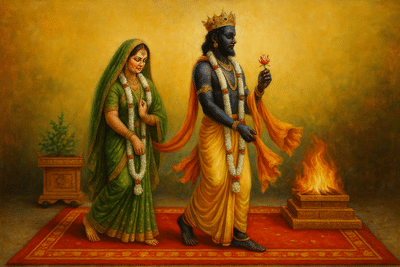
Among the countless tales in Hindu mythology, few are as spiritually symbolic as the divine marriage of Tulsi and Lord Vishnu in the form of Shaligram. Every year, during the month of Kartik (October–November), millions of devotees celebrate Tulsi Vivah a sacred union that marks the end of Diwali and the beginning of the Hindu wedding season. But behind this beautiful ritual lies a lesser-known legend the story of Vrinda, a devoted wife, whose purity and curse gave rise to two of Hinduism’s most sacred symbols: the Tulsi plant and the Shaligram stone.
1. Vrinda
 Why Are Only Men Considered Protectors? This Raksha Bandhan, Women Are Tying Rakhis to Women—Heres Why It Matters
Why Are Only Men Considered Protectors? This Raksha Bandhan, Women Are Tying Rakhis to Women—Heres Why It Matters
Vrinda, also known as Tulsi Devi, was the devoted wife of Jalandhar, a powerful demon born from Lord Shiva’s anger. Jalandhar’s unmatched strength was rooted in Vrinda’s unwavering chastity and devotion. As long as she remained pure and faithful, no god or demon could defeat him. Her spiritual power became his armor, protecting him even against Lord Vishnu and Lord Shiva.
2. The Deception That Changed the Cosmos Unable to defeat Jalandhar, the gods turned to Lord Vishnu for help. To restore cosmic balance, Vishnu took on Jalandhar’s form and appeared before Vrinda while her husband was away at battle. Believing him to be her husband, she unknowingly broke her vow of chastity and at that very moment, Jalandhar was slain. When Vrinda realized the deception, her grief turned to divine fury. She cursed Lord Vishnu, declaring, “You will turn into a stone and feel the pain of separation as I do.” Her words became truth Vishnu transformed into the Shaligram stone, and Vrinda’s mortal body became the Tulsi plant.
3. From Curse to Eternal Union: The Birth of Tulsi Vivah

Why Lord Vishnu Married a Plant: The Untold Story of Tulsi and Shaligram
Though Vrinda’s curse was born from sorrow, it was also an act of divine destiny. Realizing her devotion was pure and eternal, Lord Vishnu forgave her and blessed her with immortality. He promised, “You will be worshipped alongside me forever. No ritual, no prayer, and no offering to Vishnu will be complete without Tulsi.” Thus, the Tulsi–Shaligram Vivah became a sacred reminder of forgiveness, devotion, and eternal love celebrated on Prabodhini Ekadashi (the 11th day of the bright fortnight in Kartik month).4. The Symbolism Behind the Union

Why Lord Vishnu Married a Plant: The Untold Story of Tulsi and Shaligram
Tulsi Vivah is more than a ritual, it’s a profound symbol of spiritual transformation. Vrinda’s transformation into Tulsi represents purity and resilience. Vishnu’s transformation into Shaligram represents the eternal truth and divine permanence. Their union teaches that true love transcends form, time, and even rebirth. It is not bound by body or circumstance but lives eternally in faith and surrender.5. Why Devotees Still Perform Tulsi Vivah Today
Even today, devotees perform Tulsi Vivah with the same joy as a human wedding decorating the plant, performing rituals, singing hymns, and offering sweets. The ceremony symbolizes the beginning of auspicious times the wedding season and invites blessings of prosperity, harmony, and divine grace into homes.
A Love Story That Blossomed Beyond Life
The story of Tulsi and Shaligram is not merely mythology it’s a divine lesson about love, sacrifice, and the balance of dharma. What began as a curse became a cosmic reunion, proving that even in separation and sorrow, divine love finds its way to eternity. Every Tulsi leaf offered to Vishnu is a symbol of Vrinda’s devotion and a reminder that faith, once rooted in truth, can never wither.
-
Over 7,000 Truck Drivers Taken Off US Roads For Failing English Tests, Indian Drivers Hit Hard

-
M11 traffic LIVE: Huge 45-minute delays on UK motorway after police rush to crash

-
Mikel Arteta reveals concerning Viktor Gyokeres injury update ahead of key Arsenal fixture run

-
Huge machete brawl breaks out between kids in Manchester as armed police swarm street

-
University of Virginia active shooter LIVE: Police urge students to 'run, hide, fight'
